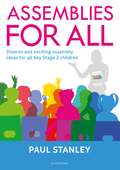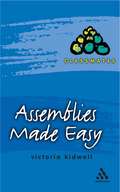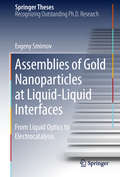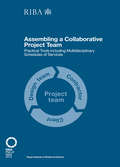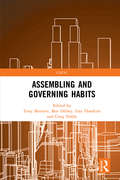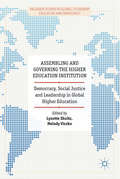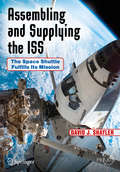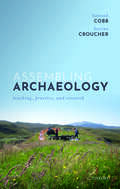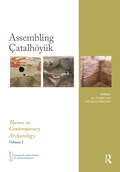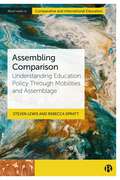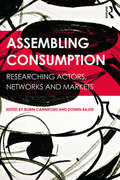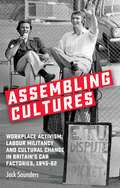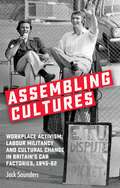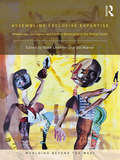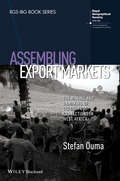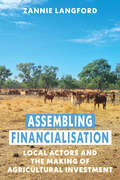- Table View
- List View
Assemblies for All: Diverse and exciting assembly ideas for all Key Stage 2 children
by Paul StanleyThis exciting collection of diverse assemblies for Key Stage 2 is perfect for any teacher or school leader looking for inspiration. Covering a range of different thought-provoking issues, each idea in this book has been successfully tried and tested in real assemblies.This flexible, dip-in resource includes a variety of assembly formats and full scripts for every assembly. Some are standalone assemblies that can be delivered with minimal preparation, some come with accompanying slideshows online and some are more detailed assemblies requiring additional resources.The topics are current and ideal for stimulating discussion, ranging from values-focused assemblies about justice, truth and courage to knowledge-based assemblies on subjects such as Black History Month and female scientists. The book uses a variety of poems, objects, folktales and real-life stories to stimulate and inspire children's thinking on topics from peace and perseverance to art and friendship.Written by an experienced headteacher dedicated to delivering assemblies that light a spark in all pupils, this resource is a must-have for all primary schools.
Assemblies Made Easy (Classmates)
by Victoria Kidwellmagine you are a mathematics teacher who gave up English and Drama when you were eighteen years old. Faced with writing a mini-production, which must be suitable for both a group of teenagers who want to look cool in front of their peers and teachers who expect a decent plot and a positive outcome, would fill you with dread, panic and stress. Kidwell not only offers practical advise on how to approach assemblies but also a selection of five minute assemblies as examples.
Assemblies of Gold Nanoparticles at Liquid-Liquid Interfaces: From Liquid Optics to Electrocatalysis (Springer Theses)
by Evgeny SmirnovThis book is devoted to various aspects of self-assembly of gold nanoparticles at liquid-liquid interfaces and investigation of their properties. It covers primarily two large fields: (i) self-assembly of nanoparticles and optical properties of these assemblies; and (ii) the role of nanoparticles in redox electrocatalysis at liquid-liquid interfaces. The first part aroused from a long-lasting idea to manipulate adsorption of nanoparticles at liquid-liquid with an external electric field to form 'smart' mirrors and/or filters. Therefore, Chapters 3 to 5 are dedicated to explore fundamental aspects of charged nanoparticles self-assembly and to investigate optical properties (extinction and reflectance) in a through manner. Novel tetrathiafulvalene (TTF)-assisted method leads to self-assembly of nanoparticles into cm-scale nanofilms or, so-called, metal liquid-like droplets (MeLLDs) with remarkable optical properties. The second part (Chapters 6 to 8) clarifies the role of nanoparticles in interfacial electron transfer reactions. They demonstrate how nanoparticles are charged and discharged upon equilibration of Fermi levels with redox couples in solution and how it can be used to perform HER and ORR. Finally, Chapter 9 gives a perspective outlook, including applications of suggested methods in fast, one-step preparation of colloidosomes, SERS substrates as well as pioneer studies on so-called Marangony-type shutters drive by the electric field.
Assembling a Collaborative Project Team: Practical tools including Multidisciplinary Schedules of Services
by Dale SinclairContemporary construction practice presents a shift in emphasis from thinking about the design team in isolation, to considering the project team as a collaborative whole: client, design team, and contractor. This approach requires greater consideration of how the project team is procured and assembled – and Assembling a Collaborative Project Team provides a range of in-depth and invaluable methods for ensuring that this essential task is carried out effectively. It will bring a range of benefits to any project – from facilitating BIM-ready teams, to better construction programming, and reducing risk through ensuring a watertight contractual framework. Many of the methods presented here are likely to become ingrained in the way all projects are coordinated. It shows that the best way of assembling a collaborative team is by establishing the team at the outset in manner that ensures that each party is fully aware of what they need to do and when, and by agreeing how this will be achieved.
Assembling a Collaborative Project Team: Practical tools including Multidisciplinary Schedules of Services
by Dale SinclairContemporary construction practice presents a shift in emphasis from thinking about the design team in isolation, to considering the project team as a collaborative whole: client, design team, and contractor. This approach requires greater consideration of how the project team is procured and assembled – and Assembling a Collaborative Project Team provides a range of in-depth and invaluable methods for ensuring that this essential task is carried out effectively. It will bring a range of benefits to any project – from facilitating BIM-ready teams, to better construction programming, and reducing risk through ensuring a watertight contractual framework. Many of the methods presented here are likely to become ingrained in the way all projects are coordinated. It shows that the best way of assembling a collaborative team is by establishing the team at the outset in manner that ensures that each party is fully aware of what they need to do and when, and by agreeing how this will be achieved.
Assembling and Governing Habits (CRESC)
by Tony BennettThe increasing significance of managing or changing habits is evident across a range of pressing contemporary issues: climate change, waste management, travel practices, and crowd control. Assembling and Governing Habits engages with the diverse ways in which habits are governed through the knowledge practices and technologies that have been brought to bear on them. The volume addresses three main concerns. The first focuses on how the habit discourses proposed by a range of disciplines have informed the ways in which different forms of expertise have shaped the ways in which habits have been managed or changed to bring about specific social objectives. The second concerns the ways in which habits are acted on as aspects of infrastructures which constitute the interfaces through which technical systems, human conducts and environments are acted on simultaneously. The third concerns the specific ways in which habit discourses and habit infrastructures are brought together in the regulation of ‘city habits’: that is, habits which have specific qualities arising out of the specific conditions – the rhythms and densities – of urban life and ones which, in the wake of the COVID-19 pandemic, have been profoundly disrupted. Written in a clear and direct style, the book will appeal to students and scholars with an interest in cultural studies, sociology, cultural geography, history of the sciences, and posthuman studies.
Assembling and Governing Habits (CRESC)
by Tony Bennett Ben Dibley Gay Hawkins Greg NobleThe increasing significance of managing or changing habits is evident across a range of pressing contemporary issues: climate change, waste management, travel practices, and crowd control. Assembling and Governing Habits engages with the diverse ways in which habits are governed through the knowledge practices and technologies that have been brought to bear on them. The volume addresses three main concerns. The first focuses on how the habit discourses proposed by a range of disciplines have informed the ways in which different forms of expertise have shaped the ways in which habits have been managed or changed to bring about specific social objectives. The second concerns the ways in which habits are acted on as aspects of infrastructures which constitute the interfaces through which technical systems, human conducts and environments are acted on simultaneously. The third concerns the specific ways in which habit discourses and habit infrastructures are brought together in the regulation of ‘city habits’: that is, habits which have specific qualities arising out of the specific conditions – the rhythms and densities – of urban life and ones which, in the wake of the COVID-19 pandemic, have been profoundly disrupted. Written in a clear and direct style, the book will appeal to students and scholars with an interest in cultural studies, sociology, cultural geography, history of the sciences, and posthuman studies.
Assembling and Governing the Higher Education Institution: Democracy, Social Justice and Leadership in Global Higher Education (Palgrave Studies in Global Citizenship Education and Democracy)
by Lynette Shultz Melody ViczkoThis book emphasizes the inherently democratic nature of education; from those who practice in higher education institutions and are involved in decision-making, to those questioning the methods of reform processes in those institutions. As they are faced with increasing pressures to restructure and change their organizations in line with global institutional demands the foundations upon which their leadership and governance are based are called into question. This book takes a critical approach to understanding higher education leadership and governance. The overarching questions asked in this book are: how has higher education come to be assembled in contemporary governance practices within the context of global demands for reform and how are issues of justice being taken up as part of and in resistance to this assemblage?
Assembling and Supplying the ISS: The Space Shuttle Fulfills Its Mission (Springer Praxis Books)
by David J. ShaylerThe creation and utilization of the International Space Station (ISS) is a milestone in space exploration. But without the Space Shuttle, it would have remained an impossible dream. Assembling and Supplying the ISS is the story of how, between 1998 and 2011, the Shuttle became the platform which enabled the construction and continued operation of the primary scientific research facility in Earth orbit. Fulfilling an objective it had been designed to complete decades before, 37 Shuttle missions carried the majority of the hardware needed to build the ISS and then acted as a ferry and supply train for early resident crews to the station. Building upon the decades of development and experience described in the companion volume Linking the Space Shuttle and Space Stations: Early Docking Technologies from Concept to Implementation, this book explores • a purpose-built hardware processing facility • challenging spacewalking objectives • extensive robotic operations • undocking a unmanned orbiter The experience and expertise gained through these missions allows space planners to improve space construction skills in advance of even more ambitious plans in the future.
Assembling Archaeology: Teaching, Practice, and Research
by Hannah Cobb Karina CroucherAssembling Archaeology provides a radical rethinking of the relationships between teaching, researching, digging, and practicing as an archaeologist in the 21st century. The issues addressed here are global and applicable wherever archaeology is taught, practiced, and researched. At its heart this book addresses the undervaluation of teaching, demonstrating that this affects the fundamentals of contemporary archaeological practice and is particularly connected to the lack of diversity in disciplinary demographics. It proposes a solution which is grounded in a theoretical rethinking of archaeological teaching, training, and practice by advocating a holistic 'assemblage' approach which challenges traditional power structures and the global marketization of the higher education system. Drawing on insights from archaeology's current material turn, this book approaches the discipline as a subject of investigation and offers a new perspective founded upon the notion of the learning assemblage, which resituates teaching and learning as a central focus and contributes to broader discourses on critical pedagogy and rhizomatic learning. It ultimately argues for a robust archaeological pedagogy that is rooted in and emergent from the material realities of the profession, and will be valuable to everyone from academia to Cultural Resource Management (CRM), heritage professional to undergraduate student.
Assembling Archaeology: Teaching, Practice, and Research
by Hannah Cobb Karina CroucherAssembling Archaeology provides a radical rethinking of the relationships between teaching, researching, digging, and practicing as an archaeologist in the 21st century. The issues addressed here are global and applicable wherever archaeology is taught, practiced, and researched. At its heart this book addresses the undervaluation of teaching, demonstrating that this affects the fundamentals of contemporary archaeological practice and is particularly connected to the lack of diversity in disciplinary demographics. It proposes a solution which is grounded in a theoretical rethinking of archaeological teaching, training, and practice by advocating a holistic 'assemblage' approach which challenges traditional power structures and the global marketization of the higher education system. Drawing on insights from archaeology's current material turn, this book approaches the discipline as a subject of investigation and offers a new perspective founded upon the notion of the learning assemblage, which resituates teaching and learning as a central focus and contributes to broader discourses on critical pedagogy and rhizomatic learning. It ultimately argues for a robust archaeological pedagogy that is rooted in and emergent from the material realities of the profession, and will be valuable to everyone from academia to Cultural Resource Management (CRM), heritage professional to undergraduate student.
Assembling Çatalhöyük (Themes in Contemporary Archaeology)
by Ian Hodder Arkadiusz Marciniak"Assembling Çatalhöyük, like archaeological remains, can be read in a number of ways. At one level the volume reports on the exciting new discoveries and advances that are being made in the understanding of the 9000 year-old Neolithic site of Çatalhöyük. The site has long been central to debates about early village societies and the formation of mega-sites in the Middle East. The current long-term project has made many advances in our understanding of the site that impact our wider understanding of the Neolithic and its spread into Europe from the Middle East. These advances concern use of the environment, climate change, subsistence practices, social and economic organization, the role of religion, ritual and symbolism. At another level, the volume reports on methodological advances that have been made by team members, including the development of reflexive methods, paperless recording on site, the integrated use of 3D visualization, and interactive archives. The long-term nature of the project allows these various innovations to be evaluated and critiqued. In particular, the volume includes analyses of the social networks that underpin the assembling of data, and documents the complex ways in which arguments are built within quickly transforming alliances and allegiances within the team. In particular, the volume explores how close inter-disciplinarity, and the assembling of different forms of data from different sub-disciplines, allow the weaving together of information into robust, distributed arguments."
Assembling Çatalhöyük (Themes in Contemporary Archaeology)
by Ian Hodder Arkadiusz Marciniak"Assembling Çatalhöyük, like archaeological remains, can be read in a number of ways. At one level the volume reports on the exciting new discoveries and advances that are being made in the understanding of the 9000 year-old Neolithic site of Çatalhöyük. The site has long been central to debates about early village societies and the formation of mega-sites in the Middle East. The current long-term project has made many advances in our understanding of the site that impact our wider understanding of the Neolithic and its spread into Europe from the Middle East. These advances concern use of the environment, climate change, subsistence practices, social and economic organization, the role of religion, ritual and symbolism. At another level, the volume reports on methodological advances that have been made by team members, including the development of reflexive methods, paperless recording on site, the integrated use of 3D visualization, and interactive archives. The long-term nature of the project allows these various innovations to be evaluated and critiqued. In particular, the volume includes analyses of the social networks that underpin the assembling of data, and documents the complex ways in which arguments are built within quickly transforming alliances and allegiances within the team. In particular, the volume explores how close inter-disciplinarity, and the assembling of different forms of data from different sub-disciplines, allow the weaving together of information into robust, distributed arguments."
Assembling Comparison: Understanding Education Policy through Mobilities and Assemblage
by Steven Lewis Rebecca SprattThis book combines assemblage theory and policy mobilities to inform the study of comparative and international education (CIE), focusing on education policy and how such policy moves are enacted. These approaches challenge taken-for granted and universalizing concepts in policy research and policy work in CIE – such as the nation-state, policy making/policy enactment, global/local, Global North/Global South – and highlight how policy is contingent on emerging through complex relations between people and places. Using illustrative cases drawn from research and practice in CIE and education development, the book demonstrates how these ideas can be used in the analysis of policy and the application of this approach in real life.
Assembling Comparison: Understanding Education Policy through Mobilities and Assemblage
by Steven Lewis Rebecca SprattThis book combines assemblage theory and policy mobilities to inform the study of comparative and international education (CIE), focusing on education policy and how such policy moves are enacted. These approaches challenge taken-for granted and universalizing concepts in policy research and policy work in CIE – such as the nation-state, policy making/policy enactment, global/local, Global North/Global South – and highlight how policy is contingent on emerging through complex relations between people and places. Using illustrative cases drawn from research and practice in CIE and education development, the book demonstrates how these ideas can be used in the analysis of policy and the application of this approach in real life.
Assembling Consumption: Researching actors, networks and markets
by Domen Bajde Robin CannifordAssembling Consumption marks a definitive step in the institutionalisation of qualitative business research. By gathering leading scholars and educators who study markets, marketing and consumption through the lenses of philosophy, sociology and anthropology, this book clarifies and applies the investigative tools offered by assemblage theory, actor-network theory and non-representational theory. Clear theoretical explanation and methodological innovation, alongside empirical applications of these emerging frameworks will offer readers new and refreshing perspectives on consumer culture and market societies. This is an essential reading for both seasoned scholars and advanced students of markets, economies and social forms of consumption.
Assembling Consumption: Researching actors, networks and markets
by Domen Bajde Robin CannifordAssembling Consumption marks a definitive step in the institutionalisation of qualitative business research. By gathering leading scholars and educators who study markets, marketing and consumption through the lenses of philosophy, sociology and anthropology, this book clarifies and applies the investigative tools offered by assemblage theory, actor-network theory and non-representational theory. Clear theoretical explanation and methodological innovation, alongside empirical applications of these emerging frameworks will offer readers new and refreshing perspectives on consumer culture and market societies. This is an essential reading for both seasoned scholars and advanced students of markets, economies and social forms of consumption.
Assembling cultures: Workplace activism, labour militancy and cultural change in Britain's car factories, 1945-82
by Jack SaundersIn British political discourse the idea that in the 1970s trade unions 'ran the country' has become a truism, a folk mythology invoked against the twin perils of socialism and strikes. But who exactly wielded power in Britain’s workplaces and on what terms?Assembling cultures takes a fine-grained look at factory activism in the motor industry between 1945 and 1982, using car manufacturing as a key case for unpicking important narratives around affluence, declinism and class. It traces the development of the militant car worker stereotype and looks at the real social relations that lay behind car manufacturing’s reputation for conflict. In doing so, this book reveals a changing, complex world of social practices, cultural norms and shared values and expectations.From relatively meagre interwar trade union traditions, during the post-war period car workers developed shop-floor organisations of considerable authority, enabling some to make new demands of their working lives, but constraining others in their more radical political aims. Assembling cultures documents in detail a historic process where, from the 1950s, groups and individuals set about creating and reproducing collective power and asks what that meant for their lives. This is a story of workers and their place in the power relations of post-war Britain.This book will be invaluable to lecturers and students studying the history, sociology and politics of post-war Britain, particularly those with an interest in power, rationality, class, labour, gender and race. The detailed analysis of just how solidarity, organisation and collective action were generated will also prove useful to trade union activists.
Assembling cultures: Workplace activism, labour militancy and cultural change in Britain's car factories, 1945-82
by Jack SaundersIn British political discourse the idea that in the 1970s trade unions 'ran the country' has become a truism, a folk mythology invoked against the twin perils of socialism and strikes. But who exactly wielded power in Britain’s workplaces and on what terms?Assembling cultures takes a fine-grained look at factory activism in the motor industry between 1945 and 1982, using car manufacturing as a key case for unpicking important narratives around affluence, declinism and class. It traces the development of the militant car worker stereotype and looks at the real social relations that lay behind car manufacturing’s reputation for conflict. In doing so, this book reveals a changing, complex world of social practices, cultural norms and shared values and expectations.From relatively meagre interwar trade union traditions, during the post-war period car workers developed shop-floor organisations of considerable authority, enabling some to make new demands of their working lives, but constraining others in their more radical political aims. Assembling cultures documents in detail a historic process where, from the 1950s, groups and individuals set about creating and reproducing collective power and asks what that meant for their lives. This is a story of workers and their place in the power relations of post-war Britain.This book will be invaluable to lecturers and students studying the history, sociology and politics of post-war Britain, particularly those with an interest in power, rationality, class, labour, gender and race. The detailed analysis of just how solidarity, organisation and collective action were generated will also prove useful to trade union activists.
Assembling Exclusive Expertise: Knowledge, Ignorance and Conflict Resolution in the Global South (Worlding Beyond the West)
by Anna Leander Ole WaeverThis book looks at the worlding of the Global South in the process of assembling conflict resolution expertise. Anna Leander, Ole Wæver and their contributors pursue this ambition by following the experts, institutions, databases and creative expressions that are assembled into conflict resolution expertise in the Global South. Expertise shapes how conflicts in the Global South are understood and consequently dealt with. Yet, expertise is always and necessarily exclusive. The exclusivity of expertise refers both to the fashionable, the sophisticated and what counts, and also to the exclusion of some people or views. Assembled from a wealth of competing knowledges expertise is always both knowledgeable and ignorant. The ambition of the volume is to explore how this exclusive expertise is assembled and in what ways it is therefore knowledgeable and ignorant of knowledges in/of the Global South. This work will be of significant interest to advanced students and scholars of conflict resolution, peace research, mediation and international relations and scholars of expertise.
Assembling Exclusive Expertise: Knowledge, Ignorance and Conflict Resolution in the Global South (Worlding Beyond the West)
by Anna Leander Ole WaeverThis book looks at the worlding of the Global South in the process of assembling conflict resolution expertise. Anna Leander, Ole Wæver and their contributors pursue this ambition by following the experts, institutions, databases and creative expressions that are assembled into conflict resolution expertise in the Global South. Expertise shapes how conflicts in the Global South are understood and consequently dealt with. Yet, expertise is always and necessarily exclusive. The exclusivity of expertise refers both to the fashionable, the sophisticated and what counts, and also to the exclusion of some people or views. Assembled from a wealth of competing knowledges expertise is always both knowledgeable and ignorant. The ambition of the volume is to explore how this exclusive expertise is assembled and in what ways it is therefore knowledgeable and ignorant of knowledges in/of the Global South. This work will be of significant interest to advanced students and scholars of conflict resolution, peace research, mediation and international relations and scholars of expertise.
Assembling Export Markets: The Making and Unmaking of Global Food Connections in West Africa (RGS-IBG Book Series)
by Stefan OumaAssembling Export Markets explores the new ‘frontier regions’ of the global fresh produce market that has emerged in Ghana over the past decade. Represents a major and empirically rich contribution to the emerging field of the social studies of economization and marketization Offers one of the first ethnographic accounts on the making of global commodity chains ‘from below’ Denaturalizes global markets by unpacking their local engagement, materially entangled construction, need for maintenance, and fragile character Offers a trans-disciplinary engagement with the construction and extension of market relations in two frontier regions of global capitalism Critically examines the opportunities and risks for firms and farms in Ghana entering global fresh produce markets
Assembling Export Markets: The Making and Unmaking of Global Food Connections in West Africa (RGS-IBG Book Series)
by Stefan OumaAssembling Export Markets explores the new ‘frontier regions’ of the global fresh produce market that has emerged in Ghana over the past decade. Represents a major and empirically rich contribution to the emerging field of the social studies of economization and marketization Offers one of the first ethnographic accounts on the making of global commodity chains ‘from below’ Denaturalizes global markets by unpacking their local engagement, materially entangled construction, need for maintenance, and fragile character Offers a trans-disciplinary engagement with the construction and extension of market relations in two frontier regions of global capitalism Critically examines the opportunities and risks for firms and farms in Ghana entering global fresh produce markets
Assembling Financialisation: Local Actors and the Making of Agricultural Investment
by Zannie LangfordFarmers, Indigenous organisations, government and private-sector intermediaries from remote Northern Australia often negotiate with private finance capital to gain funds for agricultural development.The concept of financialisation is used to explore the drivers and effects of agrifood restructuring in the area, while assemblage theory is applied to position local actors as potential sites of power in negotiating connections between local spaces and global finance. This book demonstrates that while financialisation is a useful signifier of patterns of global change, it is assembled by a diverse range of often contradictory work.
Assembling Financialisation: Local Actors and the Making of Agricultural Investment
by Zannie LangfordFarmers, Indigenous organisations, government and private-sector intermediaries from remote Northern Australia often negotiate with private finance capital to gain funds for agricultural development.The concept of financialisation is used to explore the drivers and effects of agrifood restructuring in the area, while assemblage theory is applied to position local actors as potential sites of power in negotiating connections between local spaces and global finance. This book demonstrates that while financialisation is a useful signifier of patterns of global change, it is assembled by a diverse range of often contradictory work.
